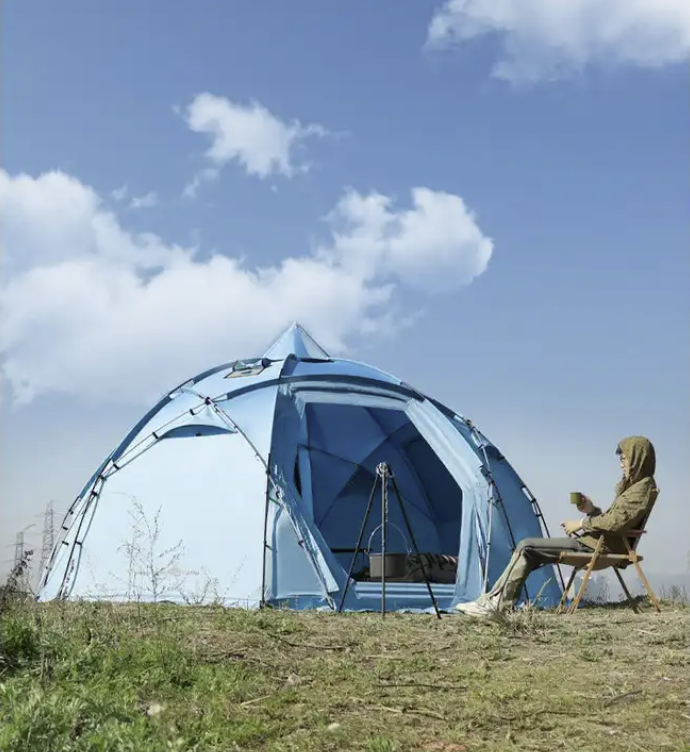Hiking Tent: Top 5 Features Every Trekker Needs


Are you considering getting a hiking tent? Trekking gives the ultimate combination of happiness and difficulties. It is a chance to detach from the digital world, indulge yourself in nature, and put yourself to the test physically. Yet the distinction between an unforgettable hike and a disappointing one lies not in the overall experience but in the small details, and one of them is the equipment you choose to carry. Among the most critical pieces of equipment is your tent: your second home.
Apart from just providing shelter after a long hike, the right tent can also improve the whole outdoor experience. However, manufacturers typically do not use the same fabric for tents. The requirements of a weekend hiker exploring within a municipal national park are not the same as those of an experienced backpacker challenging tough landscapes in far-off places. This guide gives special attention to the key aspects of hiking tent pick, exactly suited to your trip.
Weight and Portability
The first lesson found on the trail emphasizes the utmost importance of every ounce. Weight is a key variable that trekkers should consider, especially for those who plan to go for long-distance trails or minimize their load for other priorities. A heavy tent can take little time to become a big problem, it would turn what should be a pleasurable hike into a painful walk.
But weight shouldn’t be cut at the expense of durability and resistance to extreme weather. Innovations in materials and design create a tent that is both light and capable of enduring extreme weather conditions. The crux is that you have to strike the balance between the minimal weight and the highest grade of protection.
Here are some tips for balancing hiking tent weight with durability and weather resistance:
– Material Matters: Select your tent materials carefully, ultralight nylon or polyester are good choices because they balance weight and durability. The denier (D) of a cloth can help you figure out its thickness and strength possibilities. Lower numbers stand for lightweight fabrics, but higher ones are more difficult to break.
– Single vs. Double Wall: A single-wall tent is lightweight because the fly and the inner tent are joined as one layer. Nevertheless, double wall tents, involving a fly and the inner tent, are usually quite good in ventilation and condensation control. Go by your main needs and the usual weather situations you face to make this decision.
– Pole Material: Aluminium poles are more durable and carbon fiber ones are cheaper but lighter. Think about how much you are willing to spend and what kind of trekking you will be doing almost every day.
Embark on Unforgettable Adventures: Secure your Deluxe Outdoor Family Camping Tent now and ensure your next outdoor journey is both comfortable and memorable. Act fast to avoid missing out!
Capacity and Space
The size of your tent is going to be one of the major choices you’ll make. It mainly relies on the number of trekkers and how much of the gear you want to pack inside. While a smaller tent may save on weight, having plenty of space for everyone to stretch out and be comfortable makes your camping trip much more enjoyable.
Hitting the sweet spot between comfort and the need to keep weight as low as possible can be tricky. These larger tents are spacious enough to move around, change clothes, and store gear, but they are heavy and bulky as well. However, a small tent is lighter to carry but may be a bit cramped, particularly if more people stay in it or lugging a lot of equipment.
Some top hiking tents known for their spacious yet efficient design include:
– REI Co-op Half Dome: This tent has been a precious choice for backpackers who value space and lightweight attributes around comfort because of that.
– The North Face Stormbreak: With sizes ranging from one to three-person size, these tents provide ample space with headroom, as well as being lightweight, which are the perfect choice for trekkers who prefer a bit more room.
Durability and Weather Resistance
The durability of a tent and its capacity to resist harsh environmental conditions are very important for the safety and comfort of a trekking trip. Material and construction structure have a great impact on a tent’s resistance to rain, wind, and even snow.
Elevate Your Camping Experience: With a spacious design, exceptional weather resistance, and easy setup, our Deluxe Outdoor Family Camping Tent is perfect for your next outdoor adventure. Order today!
High-grade tents often rely on ripstop fabrics to keep them from tearing apart, aluminum poles for a strong frame, as well as rain flies to cover you completely from the elements. The bathtub, which is the floor of the tent should be waterproof and strong to prevent the water from entering the tent.
The tent that can survive different weather conditions should be of paramount importance. It might feel nice to pocket a few dollars off an inexpensive model, but a tent that falls apart during a thunderstorm could easily turn a pleasant trip into a dangerous situation.
Ease of Setup and Breakdown
The difficulty of putting up or taking down the tent is one of the things that may spoil your trekking adventure, especially after a tiring day on the trail or when you’re in a hurry to pitch the tent before darkness or bad weather catches up with you.
Tents with color-marked poles and connecting clips act as a guide for a hassle-free setup, which is extremely efficient for new users or bad weather conditions. One of the advantages of free-standing tents is that they can be relocated once they have been assembled allowing you to settle on the perfect spot or even reorient yourself.
The decision to select a tent that offers the comfort of setup, durability, resistant nature to the weather, and the right balance of lightness and spaciousness will undeniably make the trekking experience more enjoyable and relaxing.
Ready for All Seasons: Don’t let the weather dictate your outdoor plans. Our all-season, spacious Deluxe Outdoor Family Camping Tent is ideal for any adventure. Purchase now for year-round exploration!
Ventilation and Condensation Control Inside a Hiking Tent
Proper ventilation inside a hiking tent is crucial for both comfort and health, no matter if it’s a short stay or an extended trek and you’re inside your shelter most of the time. Good ventilation may help reduce condensation – a problem that arises from the temperature difference between the inside and outside air as well as from the moisture created by occupants’ breathing. Too much condensation will result in damp clothes, poor sleeping conditions, and possibly mold after a long time.
Strategies for reducing condensation within a hiking tent include:
– Likewise, campers and hikers must carefully select tents that have sufficient ventilation features, such as mesh panels or vents that can be opened or adjusted to allow for air circulation without letting insects or too much cold air in.
– Having a rainfly vent, which helps the moist air to leave the tent’s top without destroying the weather protection advantage.
– Putting up the tent in an area that is exposed to the breeze but not necessarily in the windy corridor to prevent excessive moisture accumulation inside the tent.
Conclusion
On embarking on a trekking expedition, the eminence of selecting a proper tent cannot be ignored. Among the vital features to think through are weight and portability, capacity and space, durability and weather resistance, ease of setup and tear down, and ventilation and condensation control. Each of these attributes is necessary as it makes your tent fit your needs whether you’re a solo backpacker or you spend your time with your group enjoying the outdoors.
Prioritizing your personal needs and wishes during the tent choice-making process will not only make your trekking experience more enjoyable but will also guarantee your safety and comfort in the wilderness. Taking into account that the tent is your base camp, the shelter, and the home away from home, and hence contributes a lot to the huge success and fun of your outdoor trips.



















Leave a comment